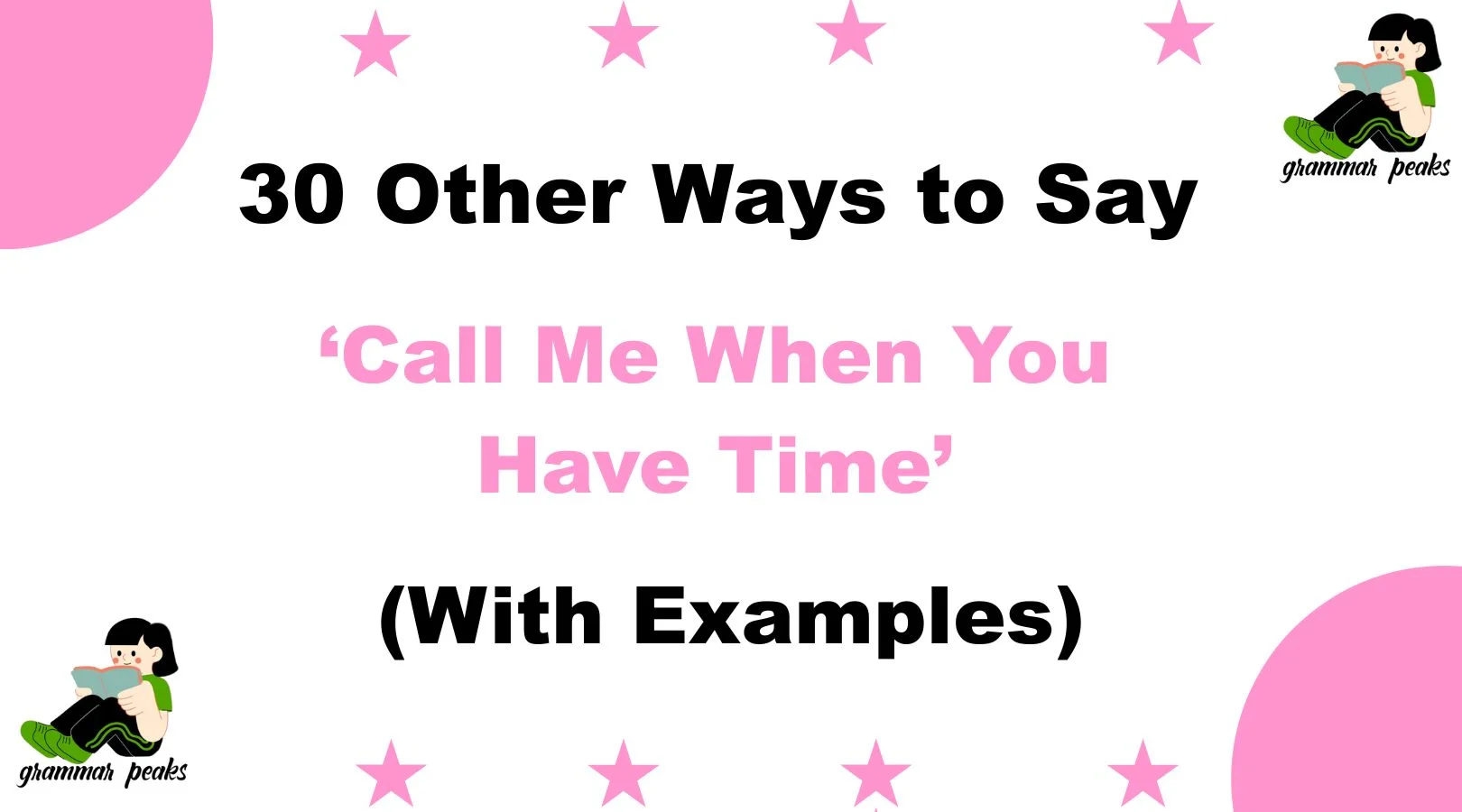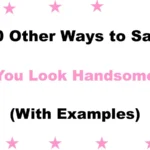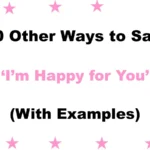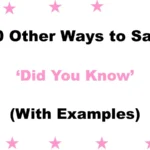Finding the right phrase can transform a simple message into a moment of connection and care. Saying “Call me when you have time” is polite but can feel routine or impersonal. Sometimes, a slight change in wording can bring warmth, clarity, or professionalism, making your message more meaningful and thoughtful. Whether you’re reaching out to a friend, colleague, or loved one, these 30 alternatives will help you express yourself with intention and kindness.
What Does “Call Me When You Have Time” Mean?
“Call me when you have time” is a polite and non-urgent way to ask someone to reach out when it’s convenient for them. It shows that you’re interested in talking but respectful of their schedule and mental space.
This phrase is often used to keep communication open without pressure, making it ideal for both personal and casual professional conversations. It expresses care, patience, and understanding, signaling that the conversation can wait and that the other person’s time and comfort are important to you.
When to Use “Call Me When You Have Time”
This phrase is ideal when:
- You want to connect without rushing the other person
- Respecting their availability matters
- You expect a longer or thoughtful conversation
- You want to keep communication open without demanding immediate attention
Is It Professional/Polite to Say “Call Me When You Have Time”?
Yes, “Call me when you have time” is generally considered both polite and professional, especially when used in the right context. It strikes a balance between being respectful and approachable, making it suitable for conversations where urgency isn’t required. In a professional setting, it conveys that you value the other person’s time and aren’t demanding immediate attention.
However, for more formal or time-sensitive communication, phrases like “Please call me at your earliest convenience” may sound more structured. Overall, it’s a warm, considerate way to initiate contact without pressure.
Pros and Cons of Saying “Call Me When You Have Time”
Pros:
- Shows respect for the other person’s time
- Creates a low-pressure environment for communication
- Works in most social and professional settings
Cons:
- Can feel vague or non-urgent
- Might delay important conversations
- Sometimes seen as too casual in formal situations
Synonyms for “Call Me When You Have Time”
- Reach out when you’re free
- Give me a ring when you’re available
- Let’s chat when you get a chance
- Call me whenever you can
- When you’re free, please call
- Touch base when it’s convenient
- Give me a call at your earliest convenience
- Ring me up when you have a moment
- When you find time, give me a shout
- Call me back when you’re ready
- Connect with me when you have a moment
- Ping me when you’re available
- Let me know when you can talk
- Call when you’re not busy
- Give me a buzz when you have time
- When you get a chance, call me
- Call me when you’re settled
- Drop me a line when you can
- Talk to me when you’re free
- Get in touch when you’re ready
- Reach me when you have time
- Give me a ring when it suits you
- Call me at your convenience
- Catch me when you can
- When you’re free, let’s connect
- Call me when you have a moment
- Call back when you get a chance
- Let’s touch base when you’re available
- Call me when you can spare a minute
- Give me a shout when you’re free
1. Reach out when you’re free
Definition: Asking someone to make contact at a convenient time.
Explanation: This phrase is warm and informal, encouraging connection without pressure.
Example: “Hey, reach out when you’re free, and we’ll catch up.”
Best Use: Casual conversations with friends or colleagues.
Worst Use: Formal business emails needing immediate response.
Tone: Friendly, relaxed.
2. Give me a ring when you’re available
Definition: A polite way to request a phone call at a suitable time.
Explanation: Slightly more formal, suitable for workplace or acquaintances.
Example: “Please give me a ring when you’re available to discuss the project.”
Best Use: Professional or semi-formal communication.
Worst Use: Overly casual or informal contexts.
Tone: Polite, respectful.
3. Let’s chat when you get a chance
Definition: Inviting a conversation when the other person is free.
Explanation: Implies a relaxed, friendly discussion without urgency.
Example: “Let’s chat when you get a chance about the event details.”
Best Use: Friendly professional or personal contexts.
Worst Use: When a quick or urgent reply is required.
Tone: Warm, approachable.
4. Call me whenever you can
Definition: Open invitation to call at any convenient time.
Explanation: Shows flexibility, leaving the timing entirely up to the recipient.
Example: “Call me whenever you can, no rush.”
Best Use: Informal, casual chats.
Worst Use: Formal or urgent communications.
Tone: Casual, patient.
5. When you’re free, please call
Definition: Polite and clear request to call when available.
Explanation: Balances politeness with clarity, suitable in many settings.
Example: “When you’re free, please call so we can finalize the details.”
Best Use: Semi-formal or professional.
Worst Use: Too formal for very close friends or family.
Tone: Courteous, straightforward.
6. Touch base when it’s convenient
Definition: Ask someone to reconnect or update you when it works for them.
Explanation: A commonly used business phrase, it’s ideal for maintaining communication without seeming intrusive.
Example: “Just touch base when it’s convenient — no rush!”
Best Use: Business conversations or professional check-ins.
Worst Use: Informal chats with close friends or family.
Tone: Professional, courteous.
7. Give me a call at your earliest convenience
Definition: A formal way of asking someone to return your call as soon as they can.
Explanation: This phrase is structured, respectful, and commonly used in professional settings.
Example: “Please give me a call at your earliest convenience regarding the report.”
Best Use: Formal emails or workplace communication.
Worst Use: Casual interactions — may sound too stiff.
Tone: Formal, polite.
8. Ring me up when you have a moment
Definition: Ask someone to call you when they find a spare minute.
Explanation: Slightly quirky and informal, this phrase adds a touch of charm.
Example: “Ring me up when you have a moment, I’ve got something funny to share.”
Best Use: Close friends, family.
Worst Use: Corporate or business emails.
Tone: Playful, casual.
9. When you find time, give me a shout
Definition: Request to be called when the other person has free time.
Explanation: Informal, often used in friendly conversations or relaxed messages.
Example: “When you find time, give me a shout. I miss hearing your voice.”
Best Use: Friends, partners, informal settings.
Worst Use: Business or formal emails.
Tone: Friendly, laid-back.
10. Call me back when you’re ready
Definition: A respectful way to ask for a return call without pressure.
Explanation: Indicates that there’s no urgency and you’re leaving the timing to them.
Example: “No rush — just call me back when you’re ready.”
Best Use: General use in both personal and semi-professional settings.
Worst Use: In urgent matters where time is critical.
Tone: Kind, flexible.
11. Connect with me when you have a moment
Definition: A soft way of asking someone to get in touch.
Explanation: Professional yet gentle, this is often used in networking or team settings.
Example: “Connect with me when you have a moment — we should align on the next steps.”
Best Use: Workplace, collaborations.
Worst Use: Too formal for casual or emotional chats.
Tone: Polished, respectful.
12. Ping me when you’re available
Definition: Ask someone to message or call when free.
Explanation: Common in digital environments; it’s fast and modern.
Example: “Ping me when you’re available. I’ll be online most of the day.”
Best Use: Tech spaces, chat platforms, coworkers.
Worst Use: Non-digital contexts or formal letters.
Tone: Modern, brief.
13. Let me know when you can talk
Definition: Ask to be informed when they’re open for a conversation.
Explanation: Friendly and direct, without sounding demanding.
Example: “Let me know when you can talk — I’d love to hear how your trip was.”
Best Use: Personal and semi-professional use.
Worst Use: Can feel vague in formal scenarios.
Tone: Neutral, caring.
14. Call when you’re not busy
Definition: Ask someone to call when they aren’t occupied.
Explanation: Shows sensitivity to their time and avoids interruption.
Example: “Just call when you’re not busy. I have something exciting to share!”
Best Use: Friends, light conversations.
Worst Use: Professional contexts may need more structure.
Tone: Relaxed, friendly.
15. Give me a buzz when you have time
Definition: A casual way to say “call me.”
Explanation: Adds personality, often used with close friends or partners.
Example: “Give me a buzz when you have time — let’s catch up.”
Best Use: Informal, familiar connections.
Worst Use: Corporate or executive communication.
Tone: Fun, familiar.
16. When you get a chance, call me
Definition: Invite someone to call without pressure.
Explanation: A softer tone than asking outright, great for flexible communication.
Example: “When you get a chance, call me. I’d love to check in.”
Best Use: General conversations.
Worst Use: High-priority topics.
Tone: Casual, light.
17. Call me when you’re settled
Definition: Suggests waiting until the other person is relaxed or available.
Explanation: Shows understanding of their current busyness or stress.
Example: “Call me when you’re settled — no rush.”
Best Use: After travel, moving, or busy days.
Worst Use: Needs more clarity in business scenarios.
Tone: Empathetic, gentle.
18. Drop me a line when you can
Definition: Ask someone to get in touch, casually.
Explanation: Often used in writing or messages, not necessarily for phone calls.
Example: “Drop me a line when you can. I’d love to hear from you.”
Best Use: Written communication or emails.
Worst Use: Urgent, verbal response needs.
Tone: Friendly, casual.
19. Talk to me when you’re free
Definition: Ask for a conversation when they’re open.
Explanation: Flexible, non-urgent approach.
Example: “Talk to me when you’re free — I’ve got news!”
Best Use: Friends, casual updates.
Worst Use: May sound too vague in serious contexts.
Tone: Relaxed, open.
20. Get in touch when you’re ready
Definition: A gentle way to initiate communication.
Explanation: Great when giving someone emotional or mental space.
Example: “Get in touch when you’re ready. I’m here whenever you are.”
Best Use: Sensitive or emotional conversations.
Worst Use: Work emails needing follow-up.
Tone: Supportive, kind.
21. Reach me when you have time
Definition: A direct version of the original phrase.
Explanation: Still polite, but slightly more proactive.
Example: “Reach me when you have time. I want to go over something with you.”
Best Use: General communication.
Worst Use: Can feel generic in some cases.
Tone: Straightforward, neutral.
22. Give me a ring when it suits you
Definition: Ask someone to call when it’s most comfortable for them.
Explanation: Respectful, flexible language, with a slightly British tone.
Example: “Give me a ring when it suits you, mate.”
Best Use: UK English users, friends.
Worst Use: Too informal for formal documents.
Tone: Casual, respectful.
23. Call me at your convenience
Definition: A formal variation asking for a callback when possible.
Explanation: Ideal for professional or diplomatic communication.
Example: “Call me at your convenience to review the terms.”
Best Use: Emails, business calls.
Worst Use: Personal, close interactions.
Tone: Professional, respectful.
24. Catch me when you can
Definition: Suggests a call when time allows.
Explanation: Slightly playful and casual, this invites interaction freely.
Example: “Catch me when you can — I’m around most evenings.”
Best Use: Casual texts or messages.
Worst Use: Professional correspondence.
Tone: Light, cheerful.
25. When you’re free, let’s connect
Definition: Invite to talk when time permits.
Explanation: Encourages two-way interaction, especially in business.
Example: “When you’re free, let’s connect on next week’s schedule.”
Best Use: Networking, work-related chats.
Worst Use: May feel impersonal in emotional discussions.
Tone: Cooperative, professional.
26. Call me when you have a moment
Definition: Ask for a short conversation when they’re free.
Explanation: Conveys the chat might be quick, easing time concerns.
Example: “Call me when you have a moment — it’s a small update.”
Best Use: Friendly or light business.
Worst Use: Serious talks requiring more prep.
Tone: Soft, inviting.
27. Call back when you get a chance
Definition: Politely request a return call when convenient.
Explanation: Casual and respectful without being too vague.
Example: “Call back when you get a chance — we’ll go over the changes.”
Best Use: Informal check-ins.
Worst Use: May cause delays in urgent discussions.
Tone: Neutral, approachable.
28. Let’s touch base when you’re available
Definition: A polite way to reconnect when both parties are free.
Explanation: Commonly used in corporate settings.
Example: “Let’s touch base when you’re available to sync on updates.”
Best Use: Project coordination, workplace talks.
Worst Use: Not ideal for personal news or emotional talks.
Tone: Professional, collaborative.
29. Call me when you can spare a minute
Definition: Suggest a brief call when they can afford the time.
Explanation: A way to indicate the call will be short.
Example: “Call me when you can spare a minute. It won’t take long.”
Best Use: Quick updates or check-ins.
Worst Use: Topics requiring depth or emotion.
Tone: Efficient, light.
30. Give me a shout when you’re free
Definition: A casual way to ask for a call or message.
Explanation: Friendly and flexible, commonly used informally.
Example: “Give me a shout when you’re free — I’ve got something fun to share.”
Best Use: Friends, casual coworkers.
Worst Use: Business emails or serious topics.
Tone: Informal, upbeat.
Conclusion
Choosing the right phrase to say “Call me when you have time” can make a big difference in how your message is received. These 30 alternatives help you adjust for tone, relationship, and purpose, offering you a thoughtful, human-centered way to stay connected.
Whether you’re sending a light message to a friend or a formal request in a business setting, these expressions give you the tools to communicate with clarity and care.
FAQs
1. Can I use these alternatives in a professional setting?
Yes. Options like “Call me at your earliest convenience” and “Let’s touch base when you’re available” are perfect for work emails and formal conversations.
2. Which phrase is best for texting a friend?
Try “Give me a buzz when you have time” or “Catch me when you can” — they’re casual, friendly, and easygoing.
3. Is “Call me when you have time” too vague?
Sometimes. If urgency matters, be more specific. Use “Call me as soon as you’re free” or “Give me a ring today if possible.”
4. Are these phrases suitable for email?
Many are. Formal ones like “Call me at your convenience” or “Reach out when you’re available” are well-suited for emails.
5. How do I choose the right phrase?
Match your tone to the relationship. Use formal phrases for work and light, casual ones for friends and family. Think about urgency, setting, and personality.

Mariah Cannon is a dedicated Senior Content Specialist at GrammarPeaks, known for her clear, engaging writing and deep knowledge of English grammar and usage. With a background in linguistics and years of experience in content development, Mariah crafts informative and accessible articles that empower readers to master the nuances of the English language. Her work reflects a commitment to clarity, education, and helping others express themselves with confidence.





